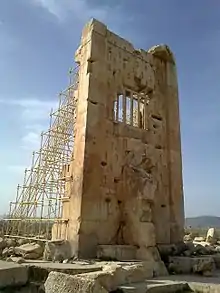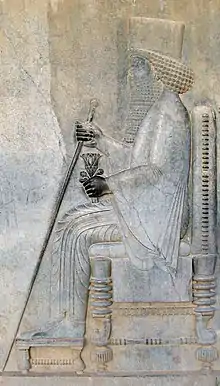Cambyses I
Cambyses I or Cambyses the Elder (via Latin from Greek Καμβύσης, from Old Persian Kabūǰiya,[2] Aramaic Knbwzy; c. 600 BC – 559 BC) was king of Anshan from c. 580 to 559 BC and the father of Cyrus the Great (Cyrus II), younger son of Cyrus I,[3] and brother of Arukku.[4] He should not be confused with his better-known grandson Cambyses II.
| Cambyses | |
|---|---|
| Great King King of Anshan[1] King of Persia | |
 Tomb of Cambyses I, Pasargadae | |
| King of Persia | |
| Reign | 580–559 BC |
| Predecessor | Cyrus I |
| Successor | Cyrus II |
| Born | 600 BC |
| Died | 559 BC (aged 41) Pasargadae |
| Burial | 559 |
| Consort | Mandane of Media |
| Issue | Cyrus the Great |
| Dynasty | Achaemenid |
| Father | Cyrus I |
| Religion | Zoroastrianism |
Early life
Cambyses was an early member of the Achaemenid dynasty. He was apparently a great-grandson of its founder Achaemenes, grandson of Teispes and son of Cyrus I. His paternal uncle was Ariaramnes and his first cousin was Arsames.
Personal life
According to Herodotus, Cambyses was "a man of good family and quiet habits". He reigned under the overlordship of Astyages, King of Media. He was reportedly married to Princess Mandane of Media, a daughter to Astyages and Princess Aryenis of Lydia. His wife was reportedly a granddaughter to both Cyaxares of Media and Alyattes of Lydia.[5] The result of their marriage was the birth of his successor Cyrus the Great. According to Nicolas of Damascus his original name was Atradates, and he was wounded and later died in the Battle of the Persian Border which he, with his son, fought against Astyages. It occurred in about 551 BC, and he is reported to have received an honorable burial.
Also according to Herodotus, Astyages chose Cambyses as a son-in-law because he considered him to pose no threat to the Median throne, having dreamt his daughter would give birth to one who would rule Asia. This was not quite the case with Cyrus the Great who would go on to depose his grandfather, and to begin the Persian Empire.
Etymology
Though numerous scholars link Cambyses to the Sanskrit tribal name Kamboja there are also few scholars who suggest the Elamite origin of the name.[6][7] Jean Przyluski had sought to find an Austric (Kol or Munda) affinity for Kamboja.[8]
Friedrich von Spiegel,[9] Sten Konow,[10] Ernst Herzfeld,[11] James Hope Moulton,[12] Wojciech Skalmowski[13][14] and some other scholars[15] think that Cambyses (Kambujiya) is adjectival form of the Sanskrit tribal name Kamboja.[16][17][9][18][11]
Spiegel also regards Kamboja/Kambujiya (Cambyses) and Kuru/Kyros (Cyrus) as the names of two pre-historic/legendary heroes of the Indo-Iranians (i.e. prior to their split into Indo-Aryans and Iranians) which were later revived naturally in the royal family of the Achaemenes and further opines that the myths about Cyrus were largely due to the confusion between the historical and the legendary heroes of the prehistoric period[19]
James Hope Moulton regards Spiegel's suggestions as the best of other etymological explanations of these two names.[12]
As against this, Arnold J. Toynbee discusses the issue of two Persian names Kambujiya (Cambyses) as well as Kurush (Cyrus) at length and regards them both as derived from the two Eurasian nomads, the Kambojas and the Kurus mentioned in the Sanskrit texts and who, according to him, had entered India and Iran in the Volkerwanderung of 8th and 7th century BC.[20][21]
Toynbee concludes that the conquest of the world by elder branch of the House of Achaemenes had been achieved by the valor of the Kuru and Kamboja Nomad reinforcements, hence as a commemoration, the elder branch of the House had named all their great princes from Cyrus I onwards, alternately, as Cyrus (Kurosh/Kuru) and Cambyses (Kambujiya/Kamboja).[22][23][24]
References
- Cyrus Cylinder
- Bachenheimer., Avi (2018). Old Persian: Dictionary, Glossary and Concordance. Wiley. p. 184.
- Allesandro Bausani (1971). "Chapter 1: The Aryans on the Iranian Plateau: The Achaemenian Empire". The Persians. St. Martin's Press. pp. 14–15.
- Muhammad A. Dandamayev. "CAMBYSES". In Encyclopædia Iranica. 15 December 1990. Retrieved 1 January 2012.
- Pierre., Briant (2002). From Cyrus to Alexander : a history of the Persian Empire. Winona Lake, IN: Eisenbrauns. p. 24. ISBN 9781575065748. OCLC 785943651.
- Tarvernier, J. (2007). Iranica in the Achaemenid Period (CA. 550-330 BC): Lexicon of Old Iranian Proper Names and Loanwords, Attested in Non-Iranian Texts. Peeters. pp. 18–19. ISBN 978-9042918337.
- Curtis, Vesta Sarkhosh; Sarah Stewart (2005). Birth of the Persian Empire, Vol. 1. I.B. Tauris. p. 21. ISBN 978-1845110628.
- Quoted in: Iranianism; Iranianism; Iranian culture and its impact on the world from Achaemenian times, 1972, p 7, Suniti Kumar Chatterji
- (Eranische Alterihumskunde, voL ii. p. 294)
- Kharoshṭhī inscriptions: with the exception of those of Aśoka, 1991, p 36, Sten Konow
- The Persian Empire, 1968, p 344-45, Ernst Herzfeld, Gerold Walser.
- See: Early Zoroastrianism, 2005, p 45, James Hope Moulton; See also: The Thinker: a review of world-wide Christian thought: Volume 2. p 490
- Studies in Iranian linguistics and philology, 2004, p 268, Wojciech Skalmowski.
- Pakistan archaeology: Issue 26, 1991, p 121, Wojciech Skalmowski, Pakistan. Dept. of Archaeology & Museums.
- See: Ṛtam: Volumes 7-10, – 1976, p 45, Akhila Bharatiya Sanskrit Parishad, Lucknow; India antiqua: a volume of Oriental studies presented by his friends and pupils to Jean Philippe Vogel, C.I.E., on the occasion of the fiftieth anniversary of his doctorate, 1947, p 184, Instituut Kern (Rijksuniversiteit te Leiden); Journal: Issue 44, 1973, p 119, K.R. Cama Oriental Institute
- The Persian Empire: Studies in geography and ethnography of the ancient Near East, 1968, p 344 sqq, Ernst Herzfeld, Gerold Walser
- Historia (Ammienus Marcellinus), 1977, p 90, Art 199/200, Edourard Galletier, Jacques Fountaine.
- Orientalia Lovaniensia periodica: Issues 24-25, 1993, p 74, W. Skalmowski, Institut orientaliste de Louvain
- Die Altpersischen Keilinscheiften: Im Grundtexte Mit Uebersetzukg, Grammatik Und Glossar, 1881, pp 85/ 86, Friedrich von Spiegel; Cf: Kuhn’s Beiträge zur vergleichenden Sprachforschung auf dem Gebiete der Arischen, Celtischen, Und Slawischen Sprachen, Volume-1, 1858, p 36/37, Friedrich von Spiegel, (Ed) August Schleicher
- According to Toynbee: "...the occurrence of the two names (i.e Kuru and Kamboja) in Transcaucasia as well as in and near India—and in Transcaucasia at close quarters—indicates that we have here two more names of Eurasian Nomad peoples who took part, and this in one another's company, in the Volkerwanderung of eighth and seventh centuries B.C; and, if, like so many of their fellows, these Kurus and Kambojas split into two wings whose paths diverged so widely, it does not seem unwarrantable to guess that a central detachment of this pair of migrating peoples may have found its way to Luristan and there have been taken into partnership by Kurus I's father Cispis." (See: A study of history: Volume 7, 1961, p 553 seq, Arnold Joseph Toynbee, Edward DeLos Myers, Royal Institute of International Affairs).
- See also: Political and social movements in ancient Panjab (from the Vedic age up to the Maurya period), 1964, pp 105/06, 126, Buddha Prakash; Cf: Modern Researches in Sanskrit: Dr. Veermani Pd. Upadhyaya Felicitation Volume. Patna: Indira Prakashan, 1987, Misra, Satiya Deva (ed.).
- Observes A. J. Toynbee: If the Lydian Monarchy had broken the force of the Cimmerian horde in Anatolia and had imposed its own rule as far eastwards as the River Halys, the Lydians had owed their success to the valour of their mercenary Spardiya Nomad cavalry; and as for the conquest of the World by the elder branch of the House of Achaemenes, as the alternating name of Kurus and Kambujiya born by their princes from Cyrus-I onwards testify, their fortune had been made for them by the valour of the Kuru and Kamboja Nomad reinforcements (See: Estudio de la historia: Volume 7, Part 2, 9161, pp 577/78, Arnold Joseph Toynbee OR A study of history: Volume 7, 1961, pp 553 seq, 580 seq, Arnold Joseph Toynbee, Edward DeLos Myers, Royal Institute of International Affairs).
- Political and social movements in ancient Panjab (from the Vedic age up to the Maurya period), 1964, p 126, Buddha Prakash
- Punjab history conference. Punjabi University, Patiala, 1996, Gursharan Singh (ed.) ISBN 81-7380-220-3 ISBN 81-7380-221-1.
Cambyses I Born: c. 600 BC Died: 559 BC | ||
| Preceded by Cyrus I |
King of Anshan 580 BC – 559 BC |
Succeeded by Cyrus the Great |


